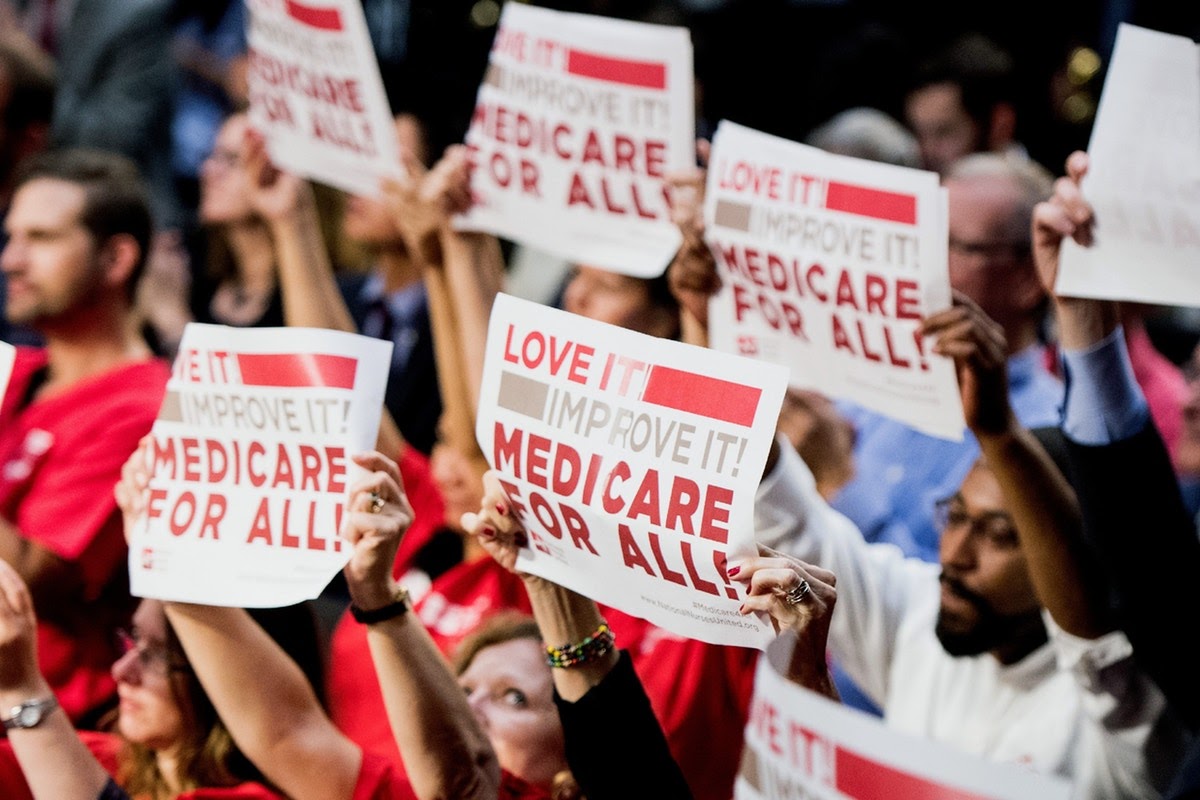Medicare-for-All is not enough, but it’s a start
This short article adds to my longer article, A Single-Payer Healthcare System for All Americans.
Some say Medicare-for-All is not enough, but it’s a good start. Republicans, on the other hand, say the Bernie Sanders “Medicare-for-All” plan would cost the government $32 trillion over 10 years, but Koch-funded research shows it’s actually LESS than the >$3.65 trillion/year we now pay, or the $7 trillion/year we’d pay in 2028 if trends continue. (Update: 2022 spending was over $4.3 trillion.)
Universal Healthcare would insure everyone without the need for private or employer-provided policies. It actually would cost a bit less and shift the expense burden to taxes, but it won’t address the underlying problems of treating sickness as a profitable industry — at least not alone.
The potential savings of health reform is FAR greater than either Democrats or Republicans have proposed so far. It would be well over $2 trillion/year if we were to cut healthcare spending in half to match what other advanced nations pay for their superior outcomes and universal coverage.
Medicare-for-All is not enough, and to reach our health reform potential, we must first understand Why American Healthcare is So [darn] Expensive to begin with. Then, we must shift the focus from just Treatment to focus on Prevention and Wellness. After all, “an ounce of prevention is worth a pound of cure.”
To maximize the potential, we must view Health as a strategic investment in worker productivity and a driver of economic growth; and we must understand and overcome the obstacles. That includes resistance and political lobbying from the medical industrial complex (insurers, hospitals, drug companies, testing companies, and medical equipment providers).
Beyond paying politicians, the medical cartel also pays (bribes) doctors to support their products in medical journal articles and medical conference speeches. It stacks state Medical Boards to limit regulation and legal liability. And it sets the medical school curriculum to maximize profits. New doctors mostly learn how to diagnose and treat illness and injury, because the biggest profits come from treatment. So there’s not enough emphasis on cure and even less on prevention, which is not as profitable. Sadly, new docs learn relatively little about the pillars of health, including nutrition, exercise, sleep, and stress-deduction.
Not only do I believe the U.S. can cut healthcare costs in half with the right focus, but with a healthier and more skilled workforce, we should also be able to increase productivity and generate another $1 trillion or so in revenue while improving GDP and global competitiveness.
NET: Taxpayer funded Universal Healthcare is a fiscally conservative policy that invests in Health with massive long-term benefits. By offering no ACA alternative for nearly a decade, Conservatives have shown us that they are driven more by wealthy special interests than public interests. But I don’t think any of the Democrat Medicare-for-All plans come close to the potential of more-comprehensive reforms.
ABOUT THE AUTHOR
Wayne Caswell is a retired IBM technologist, futurist, market strategist, consumer advocate, sleep economist, and founding editor of Modern Health Talk. With international leadership experience developing wireless networks, sensors, and smart home technologies, he’s advocated for Big Broadband and fiber-to-the-home while also enjoying success lobbying for consumers. He considers himself independent, but leans left to support progressive policies. (contact & BIO)



Would Bernie Sanders’ Medicare-for-all save Americans money? (6/4/2019)
QUESTIONABLE MOTIVES — Be very suspicious of articles and ads like this, promoted by an industry that profits so perversely from treating illness and injury but has little incentive to prevent or cure it. Watch out, because this industry has an incentive to mislead and a history of paying doctors to publish academic papers with half-truths that appear credible but hide their true intent.
WHAT’S AT STAKE? Well over $1.5 trillion/year if disruptive reforms are able to cut spending by half to match other advanced nations with their better longevity and outcomes. That estimate is based on the fact that we spent almost $3.65 trillion last year. What might we expect from the medical industrial complex with so much at stake?
OVERUSE — Sanders stretches the truth too, with a motive to get elected. His generous benefits and the elimination of cost-sharing would cause overuse and likely would not pass, but most of his other arguments are sound.
EFFICIENCY — Compared to private insurance, Medicare has immense negotiating power, far more efficient claims processing, and no profit motive; so extending that single-payer model makes good fiscal sense. But it alone won’t cut costs in half. For that we must go beyond how we PAY for care and also improve delivery and other parts of the system, including hospitals & clinics, drug companies, testing companies, and medical equipment providers.
HOLISTIC VIEW — We must address the entire system and know “Why American Healthcare is So Expensive” to begin with. (https://mHealthTalk.com/expensive/)
HERE I AGREED — “There is really only one certainty when making big changes to the health-care industry: There will be unintended consequences. Medicare-for-all would involve disruption in the health-care market much larger than what the United States experienced with the implementation of the Affordable Care Act, Medicaid or the original implementation of Medicare.”
Industry insiders see that disruption as bad, because it threatens their jobs and perverse profits. The rest of us see it as good, because we imagine how our nation might use $1.5 trillion/year in savings. We also know a healthier workforce would increase workforce productivity, company profits, wages, GDP, and global competitiveness.
RELATED ARTICLES (as I find them)
Learning From Cuba’s ‘Medicare for All’ (NY Times)
Medicare-for-All: We read Democrats’ 8 plans for universal health care. Here’s how they work. (Vox) ““Medicare-for-all” has become a rallying cry on the left, but the term doesn’t capture the full scope of options Democrats are considering to insure all (or at least a lot more) Americans. Case in point: There are half a dozen proposals in Congress that envision very different health care systems.” None of them go far enough to cut healthcare spending in half and match what other advanced nations spend (per capita or GDP percent).
Medicare-at-55 could gain momentum in 2019 (Forbes) COMMENT: With Healthcare the top voter issue in midterm elections, the time is right to go for comprehensive healthcare reform, with a phase-in codified into law.
Beyond the Affordable Care Act is the proposal of Physicians for a National Health Program, a single issue organization advocating for a universal, comprehensive single-payer national health program.
Why American Health Care is So Expensive — This article starts with a video by Ezra Klein that helps explain why our health care is so expensive. It mentions each of the top issues I write, including the political influence of a medical cartel that profits from treating illness and injury with a fee-for-service business model.
Profit as a Disease, and Now an Epidemic — The immensely profitable medical industrial complex views patients as paying customers and works to keep them coming back, paying. Prevention, or developing a one-time cure, is far less profitable than long-term treatment. That’s largely why medical schools teach new doctors so much more about diagnosis and treatment than prevention, which doesn’t fit into the profitable business models.
Republican Sabotage of Our Health Care System — A Manufactured Crisis: Trump Administration and Republican Sabotage of our Health Care System comes from removing the insurance mandate and subsidies, and now preexisting conditions protections.
Fact-checking President Trump’s USA Today op-ed on ‘Medicare-for-All’ (Meg Kelly/The Washington Post) “Nearly every line of President Trump’s USA Today op-ed contained a false or misleading statement.” And yet USA Today published it anyway. Don’t expect any Trump supporters to fact check stories like this. They apparently like the Kool-Aid taste.
The Future of Health Care Reform — A View from the States on Where We Go from Here (New England Journal of Medicine) “What does a solutions-oriented conversation about U.S. health care look like at the state level, how do we get there, and what does a shift toward state action mean for the future of reform?”
The doctor’s strike that nearly killed Canada’s Medicare-for-all plan (Vox, 3/29/19) Building a single-payer system is hard, but not impossible. Just ask Saskatchewan.